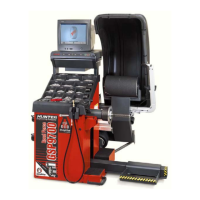136 8. Theory of Operation GSP9700 Series Road Force Measurement System Operation
The tests were performed with the vehicle running at different speeds. The first test
was at 50 miles per hour and the second test at 70 miles per hour.
At 50 MPH:
A measured 0.030” (about 30 pounds of road force) of loaded radial runout caused
the same amount of vibration as 1.5 ounces (42 grams) of wheel imbalance at 50
mph. This is 5 times greater than the 0.30 (1/4) ounce imbalance limit.
At 70 MPH:
A measured 0.030” (about 30 pounds of road force) of loaded radial runout caused
the same amount of vibration as 0.75 ounces (21 grams) of wheel imbalance at 70
mph. This is 1 1/2 times greater than the 0.30 (1/4) ounce imbalance limit.
8.6 StraightTrak
®
Lateral Force Measurement System
StraightTrak
®
Lateral Force Measurement
Although a vehicle’s suspension checks out to be acceptable, the tire pressure is
correct, the vehicle suspension is properly aligned, and the tire/wheel assembly is
perfectly round when rolling and balanced, the vehicle may still tend to pull or drift
from a straight line. Frequently the cause of this pull is excessive difference in lateral
force between the tires on the steer axle.
This optional feature measures the lateral forces of the tire/wheel assembly and
suggests placement of each tire/wheel assembly (relative to the other tire/wheel
assemblies) on the vehicle so that vehicle pull due to tire lateral forces can be
minimized or eliminated.
NOTE: StraightTrak
®
requires Lateral Force Measurement hardware
and Version 3.0 software or newer.
Tire Pull Measurement and Correction
Even after tire/wheel assemblies have been balanced, correct inflation has been set,
and suspension has been properly aligned, a vehicle may still pull from a straight line.
The cause of this pull can be due to excessive difference in lateral tire force between
the two tires on the steer axle.
The optional StraightTrak
®
Lateral Force Measurement (LFM) feature of the
GSP9700 is configured to utilize lateral force measurement information taken from a
set of vehicle tires. It provides suggested placements for the individual tires about the
vehicle, such that the net tire pull between the two tires on the steer axle are
minimized to improve or optimize the effects on vehicle handling.
When using StraightTrak
®
LFM, the basic machine cycle is the same as it has been
for the standard GSP9700, except that several additional tire revolutions have been
added to the end of the cycle so that lateral force measurements can be taken. The
only additional procedure necessary by the operator is to number, or “tag,” the tire
assembly for identification and placement when balancing is completed.
The GSP9700 will provide the operator with suggested placement of the tire/wheel
assemblies so that the net tire pull (lateral force) is minimized. There are up to twelve
alternate placement choices to offset other vehicle-related causes.
To maximize the effectiveness of StraightTrak
®
LFM, all other known sources of pull
should first be reduced as much as possible. Improper and/or uneven tire inflation,
excessive alignment angle variation side to side, and suspension/steering torque can
also directly add to the potential for a vehicle to pull, and can even increase the rate
at which the lateral forces in tires change over time.
Previously, diagnosis of such pull conditions involved the slow trial and error process
of swapping tire/wheel assembly placements in a certain order, in the attempt of
finding the least offensive placement. The amount of time involved in such a process

